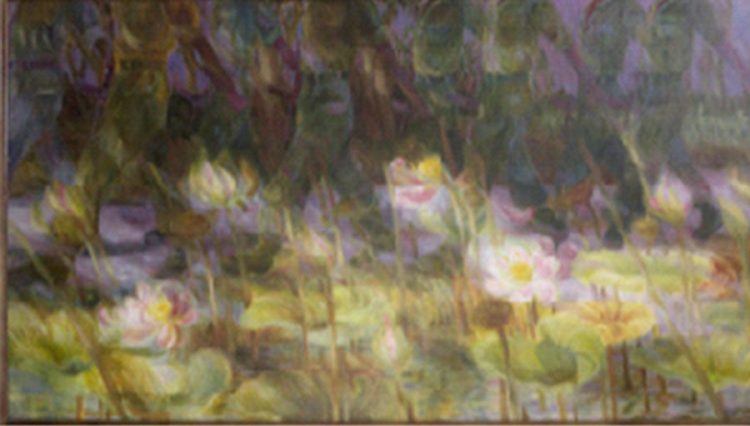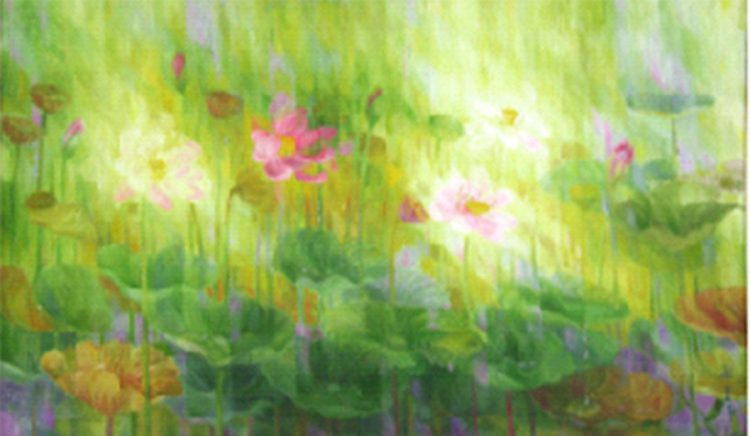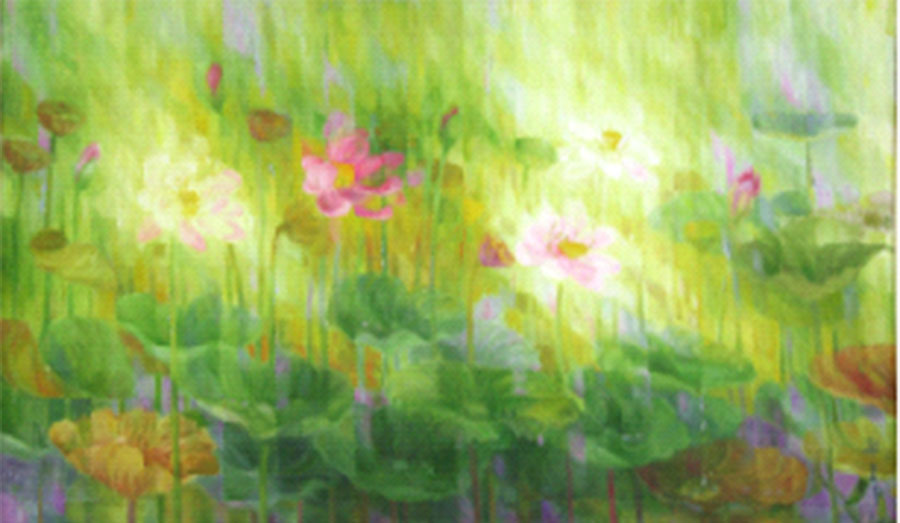 In Hinduism and Buddhism, the lotus flower holds spiritual significance that surpasses that of any other botanical. The lotus is a symbol (and not solely) of beauty, purity, and enlightenment. As a symbol of enlightenment, it reminds the individual of the ability we each possess to transcend the mire of the every day and to rise above the fray undefiled, embodying our highest self. In Hinduism, the lotus is associated with gods and goddesses of its pantheon. Some are shown seated on a lotus while others hold a lotus. The lotus is also associated with Brahma, the Creator.
In Hinduism and Buddhism, the lotus flower holds spiritual significance that surpasses that of any other botanical. The lotus is a symbol (and not solely) of beauty, purity, and enlightenment. As a symbol of enlightenment, it reminds the individual of the ability we each possess to transcend the mire of the every day and to rise above the fray undefiled, embodying our highest self. In Hinduism, the lotus is associated with gods and goddesses of its pantheon. Some are shown seated on a lotus while others hold a lotus. The lotus is also associated with Brahma, the Creator.

Persaud (Photo courtesy of the artist)
In Bernadette Persaud’s early paintings, Counterpoint (1983) (shared in Part 1 of this three-part series) and Gentlemen in the Gardens (1989), there are echoes of the significance of the lotus flower emanating from the foreground of each composition. In the former, an individual (presumably a man) in battledress is shown from the chin down with only the left half of the body visible. In hand, is a weapon which may more accurately be described as a rifle. The overall posture of the individual suggests a patrol. The painting which is a diptych (painted on two panels) shows the figure in the small right panel while the larger panel is populated with lotus flowers in a scene of tranquility and quiet mystery. In the latter painting from 1989, individuals (presumably men) march in unison from right to left within the picture plane, and behind windswept flowers in different stages of bloom in the composition’s foreground. One wonders whether the flowers’ pronounced sway towards the left of the picture plane is a result of the leftward movement of the marching human bodies. However, the tempo of the marching individuals does not appear consistent with the drastic pull endured by the flowers.
While some stalks appear to yield to a leftward pull by an invisible force beyond their natural inclination, others seem resolute to stay a vertical course. In this painting – Gentlemen in the Gardens – the stalks grow above the water, elevating the leaves, buds, and flowers. Thus, one senses in both of these images, but particularly the latter, a hopefulness for the fate of the nation. Therefore, it appears that as Persaud contemplated the social and political reality of the state, she also contemplated possibilities for undefiled beauty and unperturbed existence.
As happens in all of our lives, at some point we find ourselves contemplating the inevitable questions related to life and death. While for some the trigger may be disappointment in life’s unfolding, for Persaud the trigger was personal loss. Her contemplation on life, death, transience, permanence, and impermanence, found their way into her paintings. So, while the lotus flowers were once juxtaposed to the boots of military folk, in later paintings this and other symbols of militarism were removed and the flowers which signalled hope in the earlier paintings appear as the focus of her contemplation. Hope! Hope in trying times! Hope that life is more than a series of futile actions and that living is meant to have a loftier purpose. In Lotus of July (1991), the cycle of life is dramatised. After bursting forth from the depths of the water, the lotuses bloom for a period before time gains victory and one by one the petals fall. However, petal-less seed-filled pods remain to renew the cycle of life and death.
 Lotus of July (1991) by Bernadette Persaud
Lotus of July (1991) by Bernadette Persaud
(Photo courtesy of the artist)
In 1991, prior to returning to the classroom as a teacher and after years of extending her study of Hindu philosophy – the religion of her Indian ancestors, Persaud hosted her fourth solo exhibition Colours of God/Self at the Philip Sherlock Centre, University of the West Indies (UWI), Mona, Jamaica. This was not Persaud’s first time showing her work outside of Guyana. She had already done so in three group shows in England. Two of these were in London with one being a Guyana Women Artists’ Association exhibition hosted by the Commonwealth Institute.
In 2004, Persaud hosted yet another solo exhibition. This time it was at UWI, St Augustine, Trinidad and Tobago. Organised by friend and colleague-artist Kenwyn Crichlow, the exhibition was simply titled Recent Paintings. The installation Colours of God/Self was shown once more. According to a 2004 “Express Woman” article, “In Colours of God/Self the jhandis of Hindu deities are joined by a blue, blood-tinged Christ on one end and the Islamic crescent on the other.” The dominant subject matter of the installation was atypical for mainstream western art and certainly for art from Guyana. Persaud in the aforementioned article noted, “I wanted to get away from the rectangle. We have been grounded in western art. We have had no other grounding in any other style of art, whether African, Indian, or Chinese. That tradition will always be a half-possession. We are in a new world and we have to find our own art-form. I wanted a new concept of space.” Thus, unlike others who grappled with western visuality while attempting to assert their hybrid non-western vernacular, Persaud grounded her proposals for Caribbean-ness and Guyanese-ness in the religious culture of fore-parents with a subtle acknowledgment of assimilation.
In 2005, Persaud was a recipient of the Distinguished Visiting Artist’s Award from the Indian Council for Cultural Relations with India (ICCR). The award allowed her to take a tour of India. As a consequence of the tour, later that year, she hosted her first solo exhibition in Guyana since 1991 titled India — A Glimpse at the National Gallery of Art (NGA), Castellani House. Not quite replicating the long gap between solo exhibitions in Guyana in 2014 she mounted As New and As Old at the NGA, Castellani House. Now as we approach 2024, it seems a good time for Persaud to be supported in hosting a retrospective exhibition of work at the NGA and for her writings and those about her to be collated into a single document for all, but especially students of art to access.
In writing this three-part chronology I have focused on two thematic threads in Persaud’s work and on highlighting solo exhibitions, a major accomplishment for any artist. Thus, in doing so, I have made many omissions which at a later date must be explored. I have not discussed either the Rainforest series of images (2009 – 2014) of which there are at least nine paintings that featured prominently at Persaud’s last solo exhibition or the works informed by a study of the Koran (1993 -1995). Similarly, overlooked, are the paintings that are responsive to conflicts geographically removed from Guyana such as Gentleman Under the Sky (Gulf War) (1991) and Lotus in the Time of the Arab Spring (2011). Just as brutality removed but made immediate due to television has evoked painterly responses, so has the event that occurred along the East Coast corridor which confounded the minds of the peace-loving people. Persaud’s Tree of Death: Lusignan memorial (2010) is a quiet and dignified reflection of lives lost. Once again borrowing text from Martin Carter, Persaud returned to topics of post-coloniality in Wales Sugar Estate – Latitudes of Grief (2016-17); this important work now in the Organisation of American States (OAS) Collection has been overlooked.
I also only mentioned a very tiny fraction of group exhibitions in which Persaud has participated and thus, I have excluded the important travelling Carib Art exhibitions of the 1990s, the 9th Triennale in India, and exhibitions in the United States including the recently concluded OAS travelling Exhibition – Cultural Encounters: Art of Asian Diasporas in Latin America & the Caribbean (1945-present).
As her exhibition profile is extensive, so is Persaud’s list of critical writing. In addition to being conferred with an ICCR award, in 2012 Persaud was bestowed with the Caribbean Hall of Fame Award for Excellence in the Visual Arts and just weeks ago (on November 11, 2023) she was conferred with an Honorary Doctorate for Excellence in Arts from the University of Guyana.

